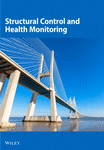Robust direct adaptive controller for the nonlinear highway bridge benchmark
Abstract
This paper presents a direct adaptive control scheme for the active control of the nonlinear highway bridge benchmark. The controller is based on the premise of direct adaptive control, where-in the system response is made to follow a desired trajectory. The principal problem of the unavailability of the correct network output is inferred from the observed structure behavior. The control force in this paper is calculated using a single hidden layer nonlinearly parameterized neural network in conjunction with a proportional-derivative type controller. The neural network is utilized to approximate the nonlinear control law, that is known to exist, and not the system nonlinearities. Stable tuning laws for the free parameters of the nonlinearly parameterized network are derived based on Lyapunov theory. Set in the framework of adaptive control, the proposed control architecture addresses important issues related to the stability of the closed loop system and parameter bounds. Performance of the proposed control scheme is evaluated on the recently proposed nonlinear highway bridge benchmark, incorporating nonlinear isolation bearings and nonlinear structural elements. Results are presented in terms of a well-defined set of performance indices. The results show that the proposed controller scheme can achieve good response reductions in the structure, without the need for the exact description of the nonlinearities, or extensive structural system information. Copyright © 2009 John Wiley & Sons, Ltd.




